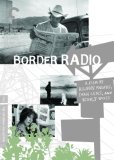Border Radio is an independent film written and directed by Allison Anders, Kurt Voss and Dean Lent. The film serves as more of a curiosity than a great film on its own merits. Released in 1987, the film fell in amongst the wave of indie filmmakers making an impact at the time, including Quentin Tarantino and Robert Rodriguez. In fact, Anders directed one of the segments in the film Four Rooms, which also featured stories by these two filmmakers, in addition to Alexandre Rockwell. While Tarantino and Ro…riguez have gone on to amazing success, many of their contemporaries never took off on a grand scale. Anders, Voss and Lent fall into this category, with Lent and Voss later directing a string of “B” movies, and Anders turning her efforts toward directing television programs.
Still, this film is an excellent example of the advice that all indie filmmakers give to aspiring filmmakers; “just make your movie!!” The goal of a debut feature is not always to make the next Reservoir Dogs as much as it is a chance to gain experience and show the world that you can handle the strain of a feature-length production. Maybe neither director went on to direct a $30 million blockbuster film, but they created a career for themselves through their work in a self-funded production.
Border Radio tells the story of a musician that steels money from a club and flees to Mexico. Once he hits the road, his wife and a friend set out to find him, resulting in a story that is both literally and metaphorically about figuring out where you are going. This is a theme that is the darling of the indie film movement, as many of the filmmakers themselves were struggling with the decision to keep working toward their dreams, or to sell out and get a real job. This is not a particularly moving or groundbreaking film, but it most certainly is an excellent example of Criterion’s mission of providing the public with important and culturally relevant films that they would never be able to experience otherwise.
Audio
As with the majority of Criterion’s releases, it is important to remember that we’re not talking about audio and video quality compared to brand new big-budget Hollywood films, as much as looking at the film in context. Therefore, it is important to remember that this is a self-financed film released in 1987. No matter how great the quality, it can’t surpass the limitations of the original source material. Criterion has completely remastered this film, however, taking out as many of the inherent flaws in the track as possible. The film was originally recorded with a Mono soundtrack, and that format has been preserved here. While the quality on this soundtrack may not be outstanding, this is probably better than it has sounded since it was recorded live.
Video
Similar arguments can be made for the quality of the video. The film is presented in its original full-screen black-and-white format. However, the film has been digitally remastered using a duplicate of the original negative, which allowed the filmmakers to move frame-by-frame through the film, removing dirt and scratches along the way. The result is a print that definitely looks better than it did when it was originally released. Only Criterion would invest the time and money required to apply a full restoration to a small independent film such as this one. Any blemishes or complaints about the picture quality at this point can be attributed directly to the creative vision of the original filmmakers.
Special Features
There are a ton of extra features here. In addition to the previously-discussed newly-remastered audio and video elements, the extras kick off with two audio commentaries, one with the directors and one with the actors. Many of the actors are independent musicians, which creates an interesting dynamic for that track. There is also a documentary that was created in 2002 called The Making of “Border Radio”, the substance of which is pretty self-explanatory.
Minor extras include nine deleted scenes and a music video. The traditional theatrical trailer is also included, as is the always enjoyable but often overlooked radio spot. There is also a stills gallery, cast and crew bios and a Criterion staple, the essay. If that’s not a packed slate of special features, then I don’t know what is.
Conclusion
It seems like an odd thing to say, but the feature film is really secondary here. The point is not to showcase a fabulous story, but to celebrate the creativity of three individuals who decided to approach filmmaking on their own terms. Clearly, Criterion recognizes this, as evidenced by the insane number of special features included on this disc. Consider this disc Independent Filmmaking 101. Under that heading, this release truly is a bargain.
Special Features List
- Two audio commentaries: one with co-directors Allison Anders and Voss, and one with actors Luanna Anders, Dave Alvin, Chris D., John Doe, and Chris Shearer
- The Making of “Border Radio”, a 2002 documentary featuring interviews with Anders, Lent, Voss, Doe, and Chris D.
- Nine deleted scenes
- Music video of the Flesh Eaters’ The Wedding Dice
- Stills gallery featuring rare behind-the-scenes photos
- Theatrical trailer and radio spot
- Bios of cast and crew
- A new essay by music journalist and critic Chris Morris






